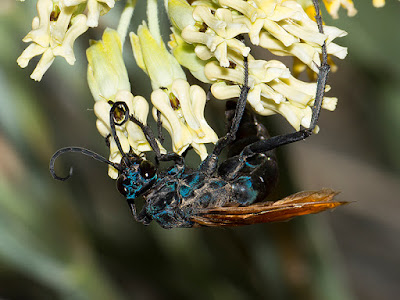Tarantula hawk wasp

Tarantula hawk wasp Tarantulas are one of the largest spider groups on the planet with leg spans that could more than cover the palm of your hand. Although their venom is not all that powerful (on a scale from meaningless to deadly to humans within half an hour), the fangs and sheer volume of poison together are enough to incapacitate any invertebrate unlucky enough to encounter it. Add to that stiff, bristly hairs and thick exoskeleton and you have an eight legged fortress complete with arsenal. What could possibly do harm to that? The answer, in western Arizona anyways, is the Tarantula hawk wasp. The wasp itself is a beauty to behold. Deep bluish black in colour with geometrically arranged antennae and a powerful thorax to drive their four wings, these are some of the largest wasps in the world. The adults themselves feed on nectar. I was out for a walk early in the morning in June, the temperature already in the high 80's (over 30° C) a...




